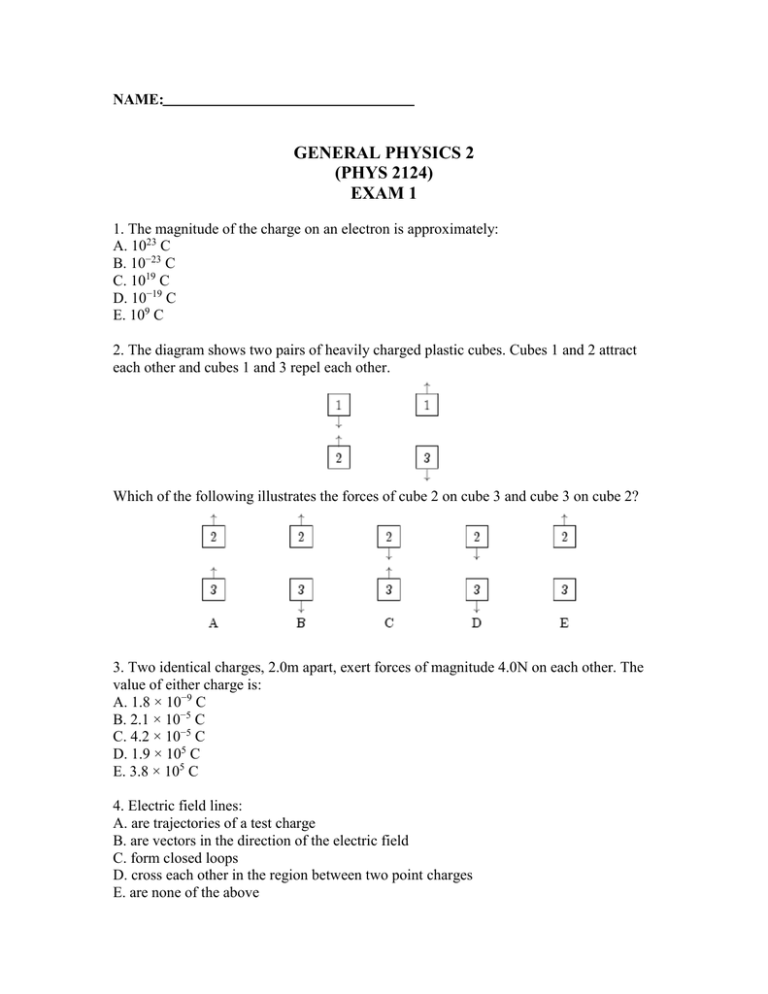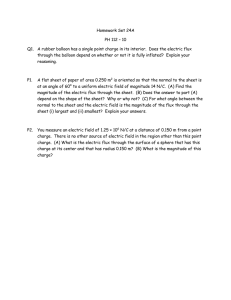GENERAL PHYSICS 2 (PHYS 2124) EXAM 1
advertisement

NAME: GENERAL PHYSICS 2 (PHYS 2124) EXAM 1 1. The magnitude of the charge on an electron is approximately: A. 1023 C B. 10−23 C C. 1019 C D. 10−19 C E. 109 C 2. The diagram shows two pairs of heavily charged plastic cubes. Cubes 1 and 2 attract each other and cubes 1 and 3 repel each other. Which of the following illustrates the forces of cube 2 on cube 3 and cube 3 on cube 2? 3. Two identical charges, 2.0m apart, exert forces of magnitude 4.0N on each other. The value of either charge is: A. 1.8 × 10−9 C B. 2.1 × 10−5 C C. 4.2 × 10−5 C D. 1.9 × 105 C E. 3.8 × 105 C 4. Electric field lines: A. are trajectories of a test charge B. are vectors in the direction of the electric field C. form closed loops D. cross each other in the region between two point charges E. are none of the above 5. The diagram shows the electric field lines in a region of space containing two small charged spheres (Y and Z). Then: A. Y is negative and Z is positive B. the magnitude of the electric field is the same everywhere C. the electric field is strongest midway between Y and Z D. Y is positive and Z is negative E. Y and Z must have the same sign 6. The diagrams below depict four different charge distributions. The charge particles are all the same distance from the origin. The electric field at the origin: A. is greatest for situation 1 B. is greatest for situation 3 C. is zero for situation 4 D. is downward for situation 1 E. is downward for situation 3 7. An isolated charged point particle produces an electric field with magnitude E at a point 2m away. At a point 1m from the particle the magnitude of the field is: A. E B. 2E C. 4E D. E/2 E. E/4 8. Charge is placed on the surface of a 2.7-cm radius isolated conducting sphere. The surface charge density is uniform and has the value 6.9 × 10−6 C/m2. The total charge on the sphere is: A. 5.6 × 10−10 C B. 2.1 × 10−8 C C. 4.7 × 10−8 C D. 6.3 × 10−8 C E. 9.5 × 10−3 C 9. When a piece of paper is held with one face perpendicular to a uniform electric field the flux through it is 25N · m2 /C. When the paper is turned 25 degrees with respect to the field the flux through it is: A. 0 B. 12N · m2/C C. 21N · m2/C D. 23N · m2/C E. 25N · m2/C 10. A point particle with charge q is at the center of a Gaussian surface in the form of a cube. The electric flux through any one face of the cube is: A. is zero B. is q/0 C. is q/40 D. is q/60 E. cannot be computed using Gauss’ law 11. Charge Q is distributed uniformly throughout a spherical insulating shell. The net electric flux in N · m2 /C through the inner surface of the shell is: A. 0 B. Q/0 C. 2Q/0 D. Q/4π0 E. Q/2π0 12. Two large insulating parallel plates carry charge of equal magnitude, one positive and the other negative, that is distributed uniformly over their inner surfaces. Rank the points 1 through 5 according to the magnitude of the electric field at the points, least to greatest. A. 1, 2, 3, 4, 5 B. 2, then 1, 3, and 4 tied, then 5 C. 1, 4, and 5 tie, then 2 and 3 tie D. 2 and 3 tie, then 1 and 4 tie, then 5 E. 2 and 3 tie, then 1, 4, and 5 tie 13. If 500 J of work are required to carry a charged particle between two points with a potential difference of 20V, the magnitude of the charge on the particle is: A. 0.040C B. 12.5C C. 20C D. cannot be computed unless the path is given E. none of these SHOW ALL WORK: In the figure below, two tiny conducting balls of identical mass m and identical charge q hang from nonconducting threads of length L. Assume that is so small that tan can be replaced by its approximate equal, sin . Show that: q2 L x 2 mg 0 1/3 SHOW ALL WORK: The figure shows a spherical shell with uniform volume charge density , inner radius a and outer radius b= 2a. What is the magnitude of the electric field at radial distances: (a) r = 0 (b) r = a/2 (c) r = a (d) r = 1.5a (e) r = b (f) r = 3b

